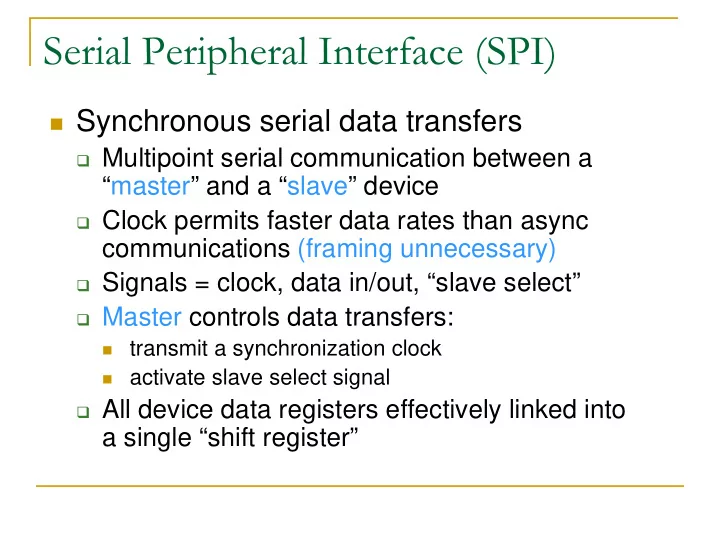

Serial Peripheral Interface (SPI) Synchronous serial data transfers Multipoint serial communication between a “master” and a “slave” device Clock permits faster data rates than async communications (framing unnecessary) Signals = clock, data in/out, “slave select” Master controls data transfers: transmit a synchronization clock activate slave select signal All device data registers effectively linked into a single “shift register”
Single master, single-slave SPI connections SS Slave Master Slave CS Select SCK Clock Shift register Shift register Gen MOSI MISO SCLK – serial clock, generated by the master MOSI – master output/slave input MISO – master input/slave output SS – slave select/enable signal
Single master, multiple slave SPI implementation Slave-selects
Single master, multiple slave SPI implementation – daisy chained • Dout of one device connected to Din of next (creates a single shift register) • All devices selected concurrently by the Master
SPI serial data timing Programmable clock rate and timing for flexibility CPOL = clock polarity (0=active-high, 1= active-low) CPHA = clock phase (sample on leading/trailing pulse edge) CPHA=0 : data output immediately when PCSn active data sampled on leading edge CPOL is the “idle” state
SPI serial data timing CPHA=1 data output on 1 st clock edge after PCSn active data sampled on trailing edge Data output Sample data PCSn active
Maxim MAX5154 12-Bit Serial DAC Data Output Chip-Select Serial Clock Data Input
MAX5154 serial data format Command and address bits select channel and conversion properties.
VTI Technologies SCP1000 Pressure Sensor Supports SPI or I2C (factory programmed) 19 bit pressure, 14 bit temperature SPI Signals I 2 C signals Trigger Data Ready
Analog Devices ADIS16003 Dual-axis accelerometer SPI Interface 12-bit acceleration/10-bit temperature
ADIS16003 Dual-axis accelerometer SPI interface timing
SST: SST25VF016B 16 Mbit SPI serial flash memory Use in DVDs, hard drives, PCs, WLANs, LCD monitors, MP3 players, FPGAs, etc. •50 MHz clock •8-lead SOIC package •7 us byte program •18 ms block erase suspend (hold) serial transfer 4-wire SPI interface write protection
SST25VF016B serial flash : device operation instructions
Motorola MC14499 7-segment LED display decoder/driver with SPI 7-segment alphanumeric LED decoder/driver drives 4 characters with decimal points NPN output drivers for common-cathode LEDs
STM32 Serial Peripheral Interface (SPI) Dual function: SPI (default) or I 2 S Synchronous, serial, full-duplex communication Configurable as SPI master or slave Programmable clock polarity/phase Programmable baud rate Supports busy-wait, interrupt, and DMA I/O
STM32 SPI block diagram Slave select
SPI data register (SPI_DR) Transmit buffer for writing / Receive buffer for reading SPI 8-bit data frame format (DFF = 0): DR[7:0] = data; DR[15:8] = 00000000 SPI 16-bit data frame format (DFF = 1): DR[15:0] = data
SPI control register 1 (SPI_CR1) BIDIMODE: 0 = 2-line/unidirectional, 1 = 1-line/bidirectional BIDIOE: bidirectional mode output enable (0 = receive, 1 = xmit) CRCEN: hardware CRC calculation enable CRCNEXT: 1 = next xfer is data (no CRC), 0 = next xfer is CRC DFF: data frame format (0 = 8-bit, 1 = 16-bit) RXONLY: receive only (0 = full duplex, 1 = output disabled/receive-only) SSM: software slave management – NSS pin ignored (1 = enable) SSI: internal slave select (this bit forced onto NSS pin if output enabled: SSOE) LSBFIRST: frame format (0 = shift out MSB first, 1 = shift out LSB first) SPE: SPI enable BR[2:0] – baud rate control (master) Fbaud = Fpclk / (2^(BR+1)) MSTR: master selection (0 = slave, 1 = master) CPOL: clock polarity (idle value) CPHA: clock phase (0 = 1 st clk transition to capture data, 1 = 2 nd )
SPI control register 2 (SPI_CR2) TXEIE: Tx buffer empty interrupt enable (on TXE flag set) RXNEIE: Rx buffer not empty interrupt enable (on RXNE flag set) ERRIE: error interrupt enable (CRCERR, OVR, MODF in SPI mode) FRF: frame format (0 = Motorola mode, 1 = TI mode) SSOE: SS output enable (if in Master mode) TXDMAEN: Tx buffer DMA enable (DMA request when TXE flag set) RXDMAEN: Rx buffer DMA enable (DMA request when RXNE flag set) DMA automatically xfers data between memory and SPI_DR
SPI status register (SPI_SR) FRE: frame format error (for SPI TI slave mode or I2S slave mode) BSY: SPI/I2S busy communicating (set/cleared by hardware) OVR: overrun error – master sends before RXNE cleared by slave MODF: master mode fault – master NSS pin lulled low(SPI only) CRCERR: CRC error in received value (SPI only) UDR: underrun error (I2S only) 1 st clock before data in DR CHSIDE: channel side to xmit/has been received (0 = left/1 = right) (I2S only) TXE: 1 = Tx buffer empty: can load next data to buffer; clears on DR write RXNE: 1 = Rx buffer not empty: valid received data in buffer; clears on DR read • Use TXE/RXNE rather than BSY for each transmission. • Trigger SPI interrupts with TXE, RXNE, MODF, OVR, CRCERR, FRE
Master Operation Setup MOSI pin = data output; MISO pin = data input. SPI_CR1: Select BR[2:0] bits to define the serial clock baud rate 1. Select CPOL and CPHA bits to define one of the four relationships between 2. the data transfer and the serial clock. Select DFF bit to define 8- or 16-bit data frame format 3. Select LSBFIRST bit to define the frame format (MSB or LSB first). 4. Set MSTR and SPE bits. 5. If the NSS pin is required in input mode, in hardware mode, connect the 6. NSS pin to a high-level signal during the complete byte transmit sequence. In NSS software mode, set the SSM and SSI bits in the SPI_CR1 register. If the NSS pin is required in output mode, the SSOE bit only should be set. Select FRF bit in SPI_CR2 to select the Motorola or TI SPI protocol. 7.
Recommend
More recommend